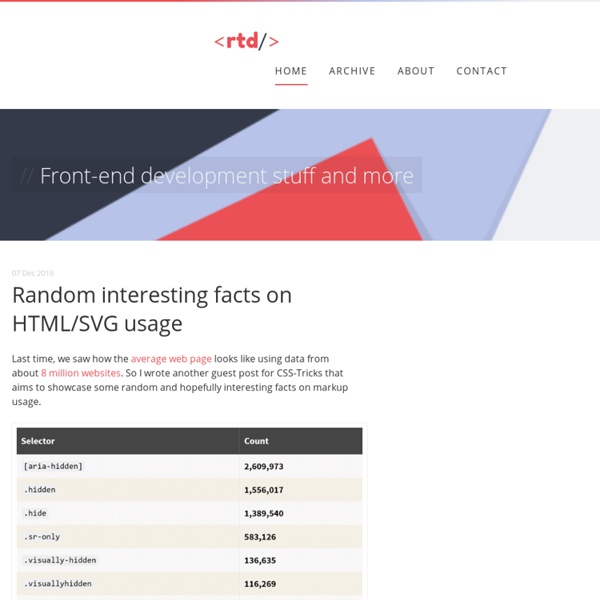



OverAPI.com | Collecting all the cheat sheets Paul Irish 10 CSS Rules Every Web Designer Should Know Through experience as web designers we memorise all kinds of code syntax, hacks and snippets. With CSS in particular there is a number of rules and declarations that can really help transform your website designs and open up new possibilities when compared to older techniques. This post rounds up 10 declarations and tips that every web designer should have available in their CSS arsenal. @media screen and (max-width: 960px) { } The @media rule not only allows you to specify styling for your web page when printed. A cool and extremely useful CSS3 property that has now gained thorough browser support is background-size. One CSS3 property that has really helped transform the web over recent years is @font-face. The clever margin: 0 auto; declaration is one of the first snippets you learn when getting to grips with CSS. For those float clearing situations where overflow: hidden; doesn’t work, the best alternative is the clearfix technique.
meyerweb.com All Standards and Drafts Nuefolio Magazine | Best Web Designing & Graphics Designing Resources -Nuefolio Magazine | Best Web Designing & Graphics Designing Resources - Slick login form with HTML5 & CSS3 We already know that CSS3 has the ability to create a lot of new possibilities to design and implement better web forms. Also, HTML5 has its important role when it comes about creating more usable forms, without actually needing any Javascript code. Knowing that, check out the below preview to see the login form we're going to create in this article: View demo Markup <form id="login"><h1>Log In</h1><fieldset id="inputs"><input id="username" type="text" placeholder="Username" autofocus required><input id="password" type="password" placeholder="Password" required></fieldset><fieldset id="actions"><input type="submit" id="submit" value="Log in"><a href="">Forgot your password? The HTML5 stuff New HTML5 attributes descriptions, according to latest specifications: The CSS For this article, I will not paste the whole lines here. Paper stack effect Box-shadow will help us creating this nice effect by defining multiple shadows that actually overlap. Stitch effect Subtle gradient lines The final result
Gazpo.com Tutorials The goal of this post is to harness some new functionality provided by CSS3 and move away from images. We are going to create a CSS3 login form without images yet still have a visually pleasing result. Read More So you just purchased a new hosting account and you some great ideas for your next project. Read More HTML5 and CSS3 are now able to be used in most modern browsers. Read More I am very excited to announce that Three Styles is now 6 Months old. Being a successful remote designer isn’t quite as simple as hopping onto a plane with your notebook. Read More Typography is often overlooked in todays design specifically by web developers.
Scalable JavaScript Application Architecture View all articles My Summary: Nicholas showed a technique to build large scale applications, one which he used during his time as an engineer at Yahoo. The technique had specific relevance to single page applications all though could be employed on Multiple page applications as well. The architecture he described split an application into multiple tiers with each tier having specific roles and responsibilities and loosely coupled so that elements could be removed, replaced or updated. Nicholas Zakas is a regular speaker on the JavaScript circuit but for some reason I'd always missed his talks at other conferences. The Abstract: Building large web applications with dozens of developers is a difficult task. Nicholas took the stage and asked "How many people are building single page JavaScript applications?" Many people are using Application frameworks like backbone.js, but many don't realise it's actually pretty easy to build your own. In total the Application Architecture consists of: